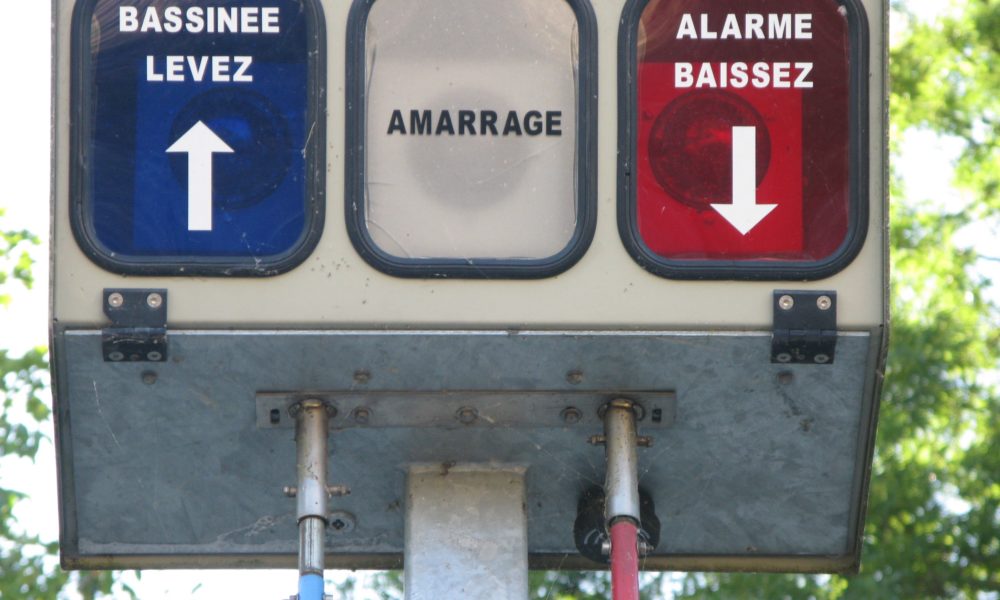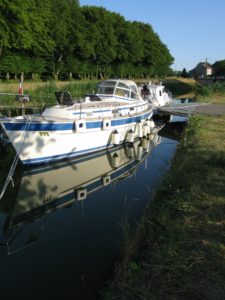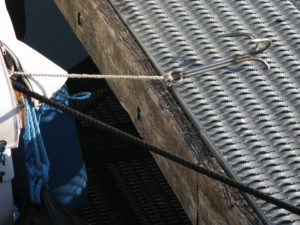In the stronghold of inland waterway sailors
47° 6′ 3.1968” N 5° 15′ 52.2792” E
July 17, 2016
We shop and break up. The air is sultry. The weather forecast promises 38 degrees, perhaps with thunder. It turns out to be a fine decision to drop the extra day in Auxonne, for out on the river there is wind and relative coolness. We sail to St-Jean-de-Losne – inland waterway sailors stronghold. Here, the multiple channels run together. Here, most sailors pass, whether south or northbound.
In a large inner harbour are 250 large riverboats. At the start of the Canal de Bourgogne is a further hundred, and out on the Saone River is the major, rebuilt boats and people like us, who with a draft of 1.75 cannot enter the inner harbour without going aground. The official Fluvia chart says otherwise, that there is room for a draft of 1.80, but several have warned us, that it has no basis in reality. There is a maximum of 1.40 meters.
After getting diesel from something as rare as a river located diesel station, we place ourselves beside a warm Dutch couple, who have moored in the river and signal us, that we are welcome outside their boat. Shortly after we get an extra bout at our side – our friends, the Swedish boat Sofia, who like us are heading towards the Mediterranean in a maxi-yacht. The boat is sailed by a couple, who are on leave until the end of October and wants to sail around Greece, where the man originally come from. He moved to Sweden in 1987.
We have been sailing with them – more or less – since Chalon-sur-Champagne, where they witnessed our fatal motor collapse on the day, that we since have tried to forget.
We explore the city. It is more charming than Auxonne, less poor, less worn, and a little more accommodating. At the same time, however it is a tiny town with its main profile from the riverboats lying all year round for the repair, winter storage, conversion. We move around in slow motion from shadow to shadow to not be affected by the heatwave, which, , according to the Norwegian weather service YR thankfully is over tomorrow, then instead we get rain showers and only 27 degrees. Hallelujah! It will be a celebration.
We are happy with YR, probably because they often promise better weather than other weather services. But let’s see.
The worst thing about heat waves are the nights. The many hours where you are bathed in sweat trying to rest. We remind ourselves, that if you want to explore the hot countries, you have to accept the heat, that comes with them. But we actually discuss these days, that conclusion on our “Ronja Around the World trip” may be, that the very best sailing ground in the world is Denmark. Well, right now we cross our fingers, that YR gets the weather right.
Log book: Today’s distance: 18 km. Sailed time from 10.00 to 12.00 = 2 hours. Locks: 1. Weather: Unbearable in port. The sun beats all day long.

Hey! 24 locks in one day…
47° 41′ 2.2524” N 5° 20′ 41.3196” E
July 14, 2015
Effective day. And pretty exhausting. We have agreed with our neighbours from Bruges in Belgium, that we will break up with them as the first of four boats, and that we follow them through the locks. Their boat, Eva, is a broad-obsessed lady, totally strapped into a corset by huge fenders all around. They offer to go first into the locks. We say yes.
The day is laborious. Lock in and lock out. Some locks on this stretch are operated by young students ,who whiz off on their mopeds to make the locks ready for us. Others – the majority – are automated and controlled with the remote control, we have been given. Today’s highlight – literally – is a voyage through a nearly five-kilometre tunnel drilled through the mountain top. Dark, damp, clammy. Water drips onto our heads. The lighting is low, just enough that we can see to keep us in the channel. We keep a flashlight in reserve.
Our start in this tunnel, Balesmes sur-Marne, was governed in good bureaucratic French manner. A series of red and green lights in the tunnel ceiling are holding us back or invite us forward, depending on whether we are sailing too fast or too slowly. Circumstantially and annoyingly engineer-like. One senses that someone sits in a central office and plays with us.
The lock is a turning point. Since the beginning of Canal entre Champagne et Bourgogne, we have only been sailing upwards. 71 locks in total. 340 meters, we have been lifted since the channel start. From now on it is downhill. Right down to the Mediterranean, we think.
We use the first locks after the tunnel to get used to going down. It is said that this is much easier. More gentle to the ship and crew. For us, it is necessary however to catch the technique. In the first locks, we use the same technique, as when we locks up. Two hawsers. One for each, close to each other. It gives a sense of control when it goes up.
But going down there is not as much pressure from floodwaters in the lock chamber. The water disappears quietly under the boat. It is much calmer, and we become comfortable with simply having a single rope to the land, while we are experimenting with making as few moves as possible and let the boat take care of itself. A single puff with a boat hook or a single jerk in the hawser is enough. Yes, obviously it is easier to lock down than up. If it were not for the sun and heat, it would be pure relaxation.
We say goodbye to the Belgians after having sailed with them through 20 locks. Although we are taking additional four locks to Dommarien, which according to the map is a berth with 1.80 meters depth for two boats. It is not.
We hit the ground long before, we reach the quayside.
Instead we sail to the right side of the canal, where a converted peniche populated with young French people is located at the brink. We ask if we can moor side by side with them. No. They ask us to find another place. Rather unheard of. Sailors always give each other space. But they are probably landlubbers. Not sailors. Kirsten, frustrated, calls all sorts of curses upon the young landlubbers.
We must try again on the berth assigned in the chart. Nope. It is impossible. We cannot reach the shore. There continues to be one to one and a half meters between Ronja and the brink. We choose to make the boat stuck on this distance of the brink with the assistance of a helpful Frenchman. Well, anyway it does not seem temptating at all to go ashore, so we do not.
The helpful Frenchman seems to be new to sailing life. He has a small motorboat, which he has connected to the shore with three ropes and an anchor, which he has fixed on top of a little metal-bridge. We have never seen this before.
We celebrate with champagne today, the impressive distance and the fact that we have passed the peak and that the next few weeks of sailing goes down towards Saone, Rhone and the Mediterranean. A clear turning point.
Log book: Today’s distance: 35 km. Sailed time 8:45 to 19:15 = 10 ½ hour. Locks: 24 !!!! Weather: Sun all day. Light breeze made sure to dampen the unit. In these waters, the wind has only one meaning: To cool. To the navigation it has virtually no impact.

Sometimes you have to improvise finding mooring for Ronja

Not alle french sailors are trained in the craft of mooring. Her is a peculiar use of an anchor